The winners of the Apollo Awards 2015 were announced last night at a ceremony at RSA House in London, attended by major figures from the art world and hosted by Apollo editor Thomas Marks. His prize-giving speech is reproduced below.
Welcome to the Apollo awards for 2015. On my own behalf as editor of Apollo, and on behalf of our tremendous team at the magazine, it gives me great pleasure to welcome you all here tonight.
What a fantastic thing it is to be hosting these awards in the Great Room at the RSA, the Royal Society for the Encouragement of Arts, Manufacture and Commerce. This is an organisation that dates to the Enlightenment, and that has, since its foundation in 1754, existed to promote cultural enlightenment, with a firm commitment to ideas and innovation as the harbingers of social progress.
We are girdled in this room by James Barry’s fresco cycle The Progress of Human Culture, one of the most ambitious examples of 18th-century history painting in Britain. Simon Schama described one of these paintings as ‘a lamentable mishmash of allegory, history and fluvial landscape that topple over into unintended comedy’… and just to be clear he was not offering a verdict on his recent TV series on the selfie. But I suppose one rejoinder might be that progress has always been uneven, and we should celebrate it thus – and indeed, it is a pleasure to stand here and think about what it meant for Barry and what it might mean to us now.
There is a fine mixture in this institution of rich history and a principled engagement in the present moment, which I like to think that Apollo might in its own way exemplify as a magazine, and that all our winners tonight reflect in their different ways. The mixture of historical sympathy, and a bearing and relevance to the present day and indeed to the future is one that Apollo strives to promote.
A quick word on the awards before we move on to the presentation. In one form or another, the Apollo Awards date back to 1992 – for a long time as paper awards, but now for the third year running celebrated with this splendid dinner and ceremony. I do think it’s important as ever that we lionise outstanding achievements in the art and museum worlds, and to do so from an independent and I hope distinctive perspective.
This has unquestionably been a sombre year for anyone invested in the arts and culture. From abroad, forlorn images have reached us of the barbaric, unrepealable desecration of archaeological sites in the Middle East. And at home, senior museum figures and commentators have warned that our museum culture may not endure with its current sense of purpose as funding for both national and regional institutions is squeezed still further. It is with an eye to these and other difficult contexts that this evening we wish to trumpet those institutions and individuals that have this year set the standards to which others should aspire.
Museum Opening of the Year
Our first award this evening is for the Museum Opening of the Year, which covers a major new building project or museum renovation. This year the field was very strong… though we resisted the temptation to create a stand-alone category for museum buildings knocked up by Renzo Piano. Our winner is a historic yet trail-blazing institution, which has upped sticks across a city, moving into a exceptional new building – a building by Renzo Piano, of course – and a regenerated district that is rapidly becoming a major cultural centre.
When I visited before the opening this spring, I was amazed by the sense of potential that ran like an electric charge through the museum and its staff: here is a place where the histories of American art can be explored in all their complexity, and that promises to buoy up and offer ballast to the American art of the future. This institution now has the superb facilities and extraordinary space to do justice to its vast collection, and to the artists who have always been so integral to its activities. I am delighted to welcome Adrian Hardwicke, director of visitor experience at the Whitney Museum of American Art to collect the award for Museum Opening of the Year.
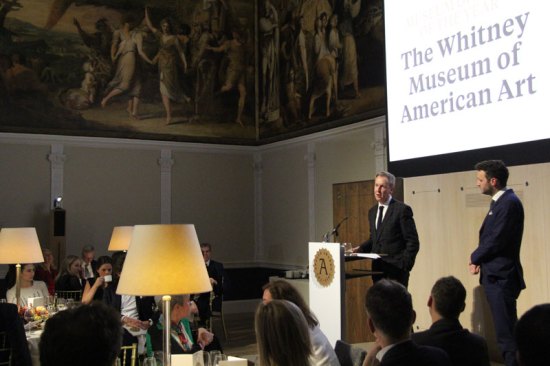
Adrian Hardwicke, director of visitor experience at the Whitney Museum of American Art, collects the Apollo Museum Opening of the Year Award
Book of the Year
The next award is for the Book of the Year. All the publications on our shortlist this year charted new art-historical territory: there was Giles Waterfield’s paean-cum-elegy to the great civic museums of 19th-century Britain; Nancy Princenthal’s bright life of Agnes Martin; Anne Markham Schultz’s unprecedented study of Tullio Lombardo; and Elain Harwood’s epic history of post-war British architecture. But our winner this year is a volume that captures the romance and adventure of research – there may indeed be such a thing – as well as the excitement of that type of discovery that rearranges a particular field, and the contours of others that lie beyond it.
The old mahogany box chanced on by Ken Jacobson and Jenny Jacobson in a small country auction in 2006 turned out to contain a hoard of daguerreotypes taken by John Ruskin, including many images of Venice and some of the earliest known photographs of the Alps. The resulting volume transforms our understanding of Ruskin’s critical methods and of his photographic pursuits, and is a major contribution to the history of early photography. I would like to invite Ken Jacobson and Jenny Jacobson to collect the award for Carrying off the Palaces: John Ruskin’s Lost Daguerreotypes.
Digital Innovation of the Year
Our next award is for the Digital Innovation of the Year, which this year has generously been supported by our loyal partners Deutsche Asset and Wealth Management. Our shortlist includes companies and social enterprises that have harnessed new technologies to increase access to public collections or improve communication and the storage of information in the commercial art world. But this year’s award, goes to a project that has responded urgently to the critical situation in Syria, Iraq and other parts of the Middle East.
The Million Image Database is sending 1000s of specially adapted cameras to conflict zones to record endangered heritage sites, in a manner that will allow for extensive digital archiving and, where necessary, the possibility of reconstruction. This is perhaps the most high-profile activity of the Institute for Digital Archaeology, which has brought together experts from the University of Oxford, Harvard University, and the Museum of the Future in Dubai; this evening we applaud its hope and its chutzpah, and the importance of the work it is carrying out in the face of a savage and uncivil threat to the shared culture of the world. Roger Michel, director of the Institute for Digital Archeology is here to collect the award.
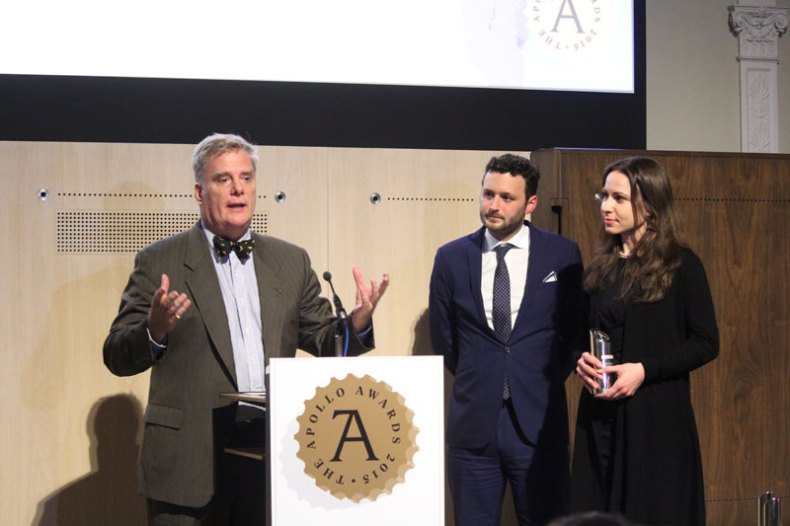
Roger Michel, director of the Institute for Digital Archeology, collects the Apollo Award for Digital Innovation of the Year, with Alexy Karenowska (right)
Exhibition of the Year
Our exhibition of the year was not one of those international blockbusters to have attracted the plaudits and press coverage this year. Rather, this was an exhibition of uncommon originality and intelligence, which breathed life into objects often hidden from view and taught us new things about how a particular artists’ tool has left its mark on the history of art. ‘Silent Partners: Artist and Mannequin from Function to Fetish’ was that rare thing: a dual triumph of sustained research and curatorial flair, which showed that learning and wit are can be mutually illuminating rather than mutually exclusive. I am very pleased to welcome the exhibition’s curator, Jane Munro, Keeper of Paintings, Drawings and Prints at the Fitzwilliam Museum, to collect the award.
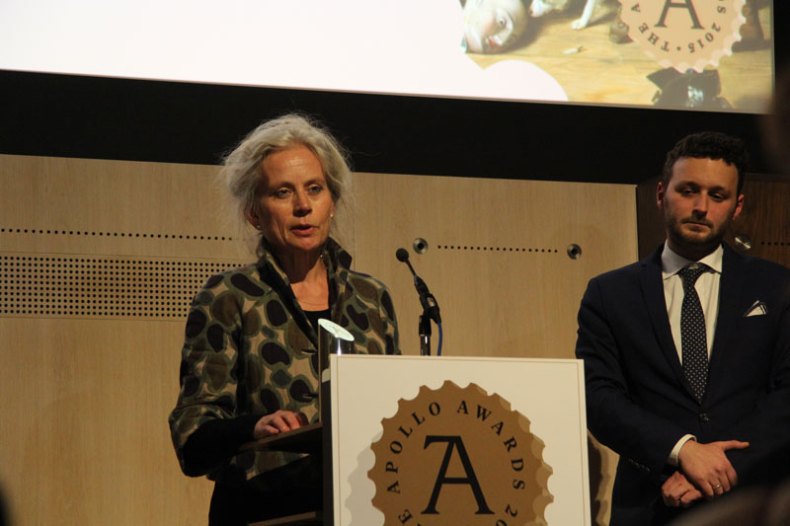
Jane Munro, Keeper of Paintings, Drawings and Prints at the Fitzwilliam Museum, and curator of ‘Silent Partners’, collects the Apollo Exhibition of the Year Award
Acquisition of the Year
We reach the acquisition of the year, which celebrates those public collections that have bolstered their holdings in the past 12 months despite the frequent challenges to doing so, not least the shrivelled acquisitions budgets of many European institutions and the ‘optimistic’ prices fetched in some sectors of the contemporary art market. The December issue of Apollo contains our annual round-up of acquisitions made by museums worldwide; and there are many astonishing works, often making their way into public collections thanks to audacious fundraising efforts or staggering acts of generosity.
This year, our acquisition of the year – our acquisitions of the year, I should say – is of great historical importance, a rare example of the scarce, suggestive presence of Italian sculptors in Britain in the 16th century and of great value to our understanding of Tudor patronage and politics: these four bronze angels were designed in the 1520s by Benedetto da Rovezzano for the tomb of Cardinal Thomas Wolsey. And it is highly fitting that, after a major fundraising campaign – partly, it must be said involving a convenient ride on the Wolf Hall bandwagon – the Wolsey Angels should have found their way into the national collection of sculpture at the Victoria and Albert Museum. It is with great pleasure that I welcome Paul Williamson, Keeper of Sculpture, Metalwork, Ceramics and Glass, to collect the award.
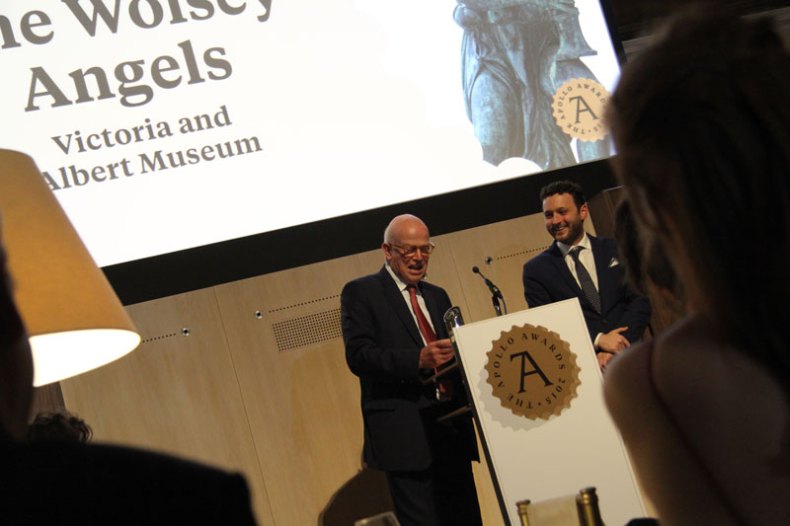
Paul Williamson, Keeper of Sculpture, Metalwork, Ceramics and Glass, collects the Apollo Award for Acquisition of the Year
Artist of the Year
Our artist of the year award goes to a figure who had a considerable public impact in 2015, whether through exhibitions, major commissions or for stirring the public and critical imagination through their work and ideas. This year, the winner is an artist of unbridled ingenuity and unstinting integrity, who engages forcefully with the history of his materials and with the truly stubborn stuff of history itself. William Kentridge has been – it is for once accurate to say – almost globally heralded this year, with exhibitions in London, Amsterdam, Beijing, Mexico City, Cape Town, and beyond. So heralded, in fact, so much so, that he is in Krakov tonight collecting another award for his services to animation. But I am delighted that his daughter, Alice Kentridge, is here this evening to pick up this award on behalf of her father.
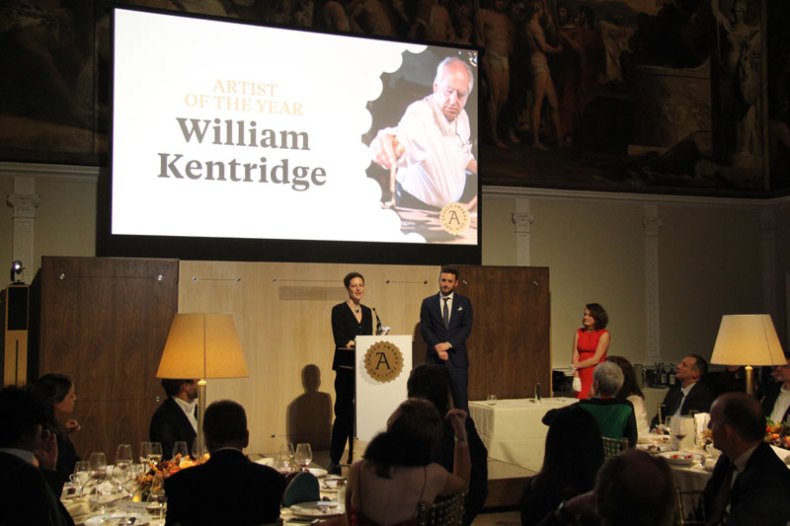
Alice Kentridge collects the Apollo Award for Artist of the Year on behalf of her father, William Kentridge
Personality of the Year
We come to our final award, our personality of the year, which this year has generously been sponsored by our friends at Sophie Macpherson Limited, the art world’s leading headhunters and recruiters. ‘In February 2008’, wrote Maria Balshaw in Apollo earlier this year, ‘I took a deep breath and asked the President of the University of Manchester for a million pounds to begin the transformation of the Whitworth Art Gallery.’ Well, that was just the start. Seven years later, the museum reopened after a £15 million redevelopment project carried out by McInnes Usher Mcknight Architects and driven through by its ambitious, and in some senses visionary director. That the building was shortlisted for the RIBA Sterling Prize this year, and that the museum won the ArtFund’s museum of the year accolade, is testament to just how far the Whitworth has opened itself to new audiences in and beyond Manchester without compromising its role as a university collection.
Maria Balshaw is held up by her peers as a model of leadership, which is just as well, given that she has also been the director of the Manchester City Galleries since 2011. Here is a director who is persuasive and decisive, and who knows above all how to get things done. We hear a lot these days about the chancellor’s northern powerhouse. With her seat on board of the Arts Council England, her involvement in the proposed Factory arts centre in Manchester, and with her clear and laudable ambitions for the institutions she represents, one might say that, in cultural terms at least, we already have a northern powerhouse – a one-women northern powerhouse, in Maria Balshaw. I would like to welcome her to the stage as Apollo’s personality of the year.
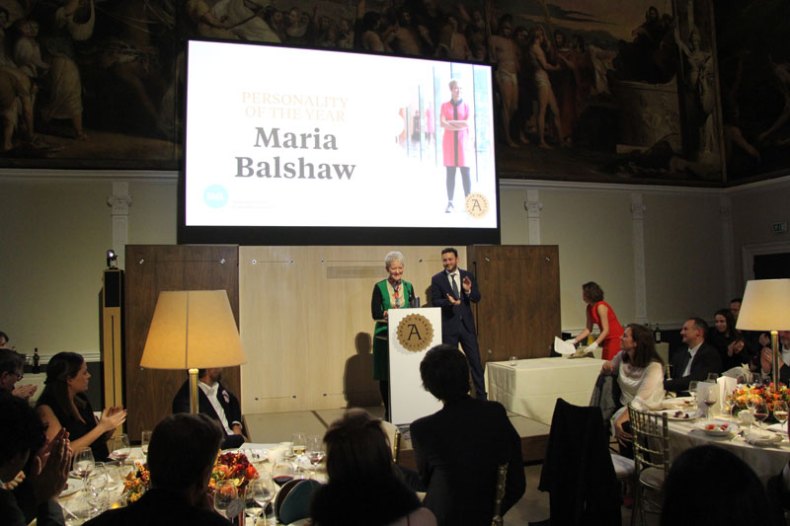
Maria Balshaw, director of the Whitworth Art Gallery and Manchester City Galleries, is Apollo’s Personality of the Year 2015
Click here for the full list of Apollo Award Winners 2015
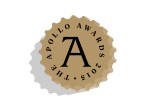
Unlimited access from just $16 every 3 months
Subscribe to get unlimited and exclusive access to the top art stories, interviews and exhibition reviews.

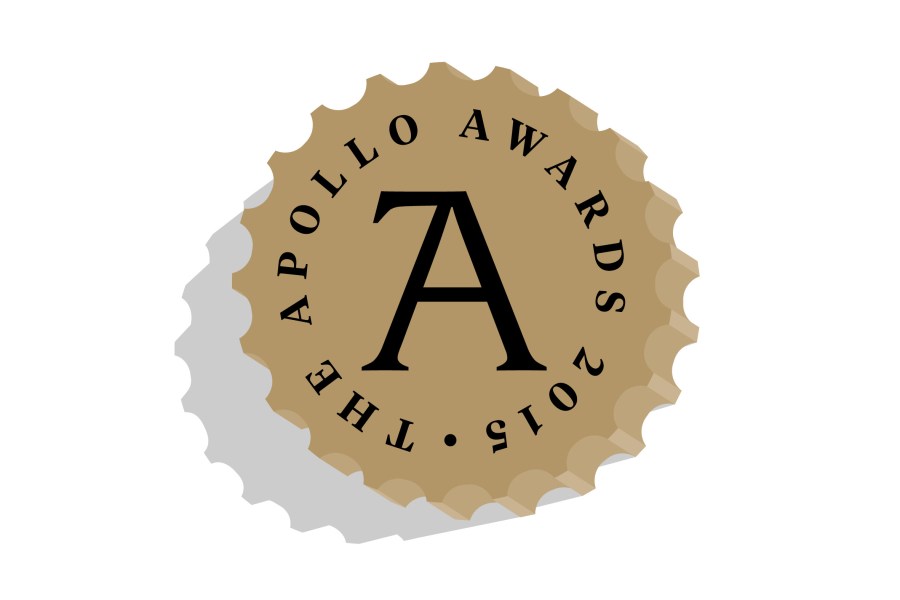
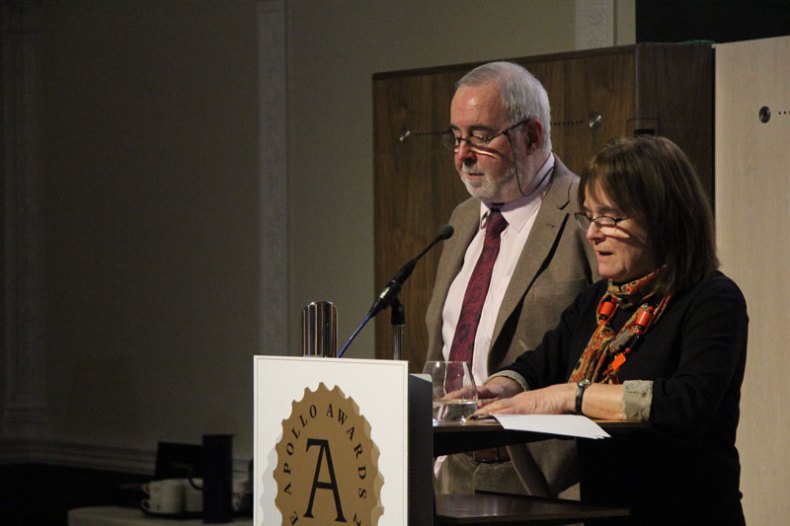
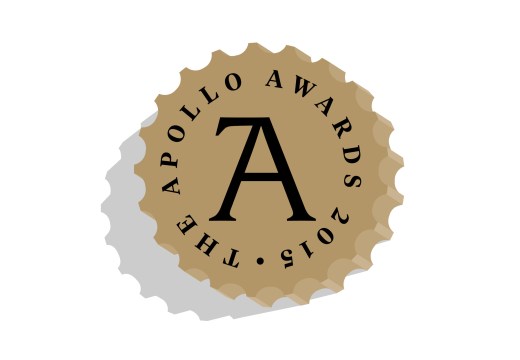
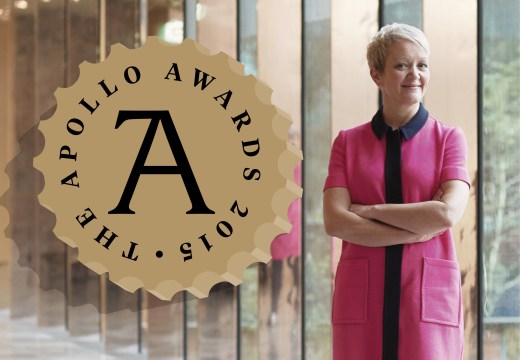
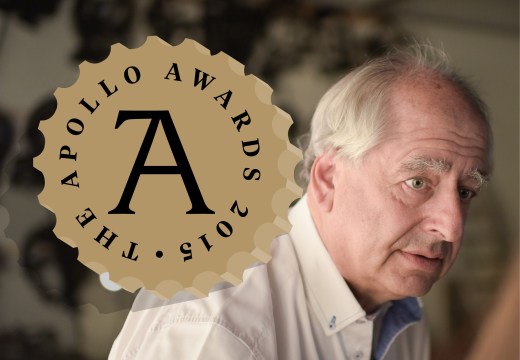









![Masterpiece [Re]discovery 2022. Photo: Ben Fisher Photography, courtesy of Masterpiece London](http://www.apollo-magazine.com/wp-content/uploads/2022/07/MPL2022_4263.jpg)
Has the Fitzwilliam lost the hang of things?